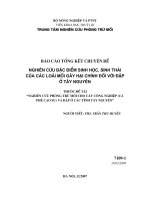Slide cao su hóa học và công nghiệp rubber curvibg systems
Bạn đang xem bản rút gọn của tài liệu. Xem và tải ngay bản đầy đủ của tài liệu tại đây (2 MB, 132 trang )
.c
om
ng
co
an
cu
u
du
o
ng
th
Rubber Curing
Systems
CuuDuongThanCong.com
/>
.c
om
• Over the years three special types of cure
cu
u
du
o
ng
th
an
co
ng
systems have been developed. They are:
• efficient vulcanisation (EV) systems,
• semi-efficient vulcanisation (SEV)
systems and
• conventional vulcanisation (CV) systems.
CuuDuongThanCong.com
/>
cu
u
du
o
ng
th
an
co
ng
.c
om
The levels of accelerator and sulfur in CV,
SEV and EV systems are shown in Table 1
CuuDuongThanCong.com
/>
cu
u
du
o
ng
th
an
co
ng
.c
om
Measuring Cure
CuuDuongThanCong.com
/>
.c
om
ng
co
an
th
ng
du
o
u
cu
CuuDuongThanCong.com
/>
cu
u
du
o
ng
th
an
co
ng
.c
om
The curve exhibits a number of features
which are used to compare cure:
- Maximum torque MH.
- tS2, T2 or T5 : there is a delay or
induction time before the torque or
resistance value begins to rise.
- T90 : is the time for the torque to
increase to:
90/100(MH − ML)+ ML
CuuDuongThanCong.com
/>
.c
om
cu
u
du
o
ng
th
an
co
ng
Cure rate: A rise in the value of torque
with time, the slope of the curve, gives
the measure of cure rate. Sometimes cure
rates of various cure systems are
compared with T90−ts2 data
CuuDuongThanCong.com
/>
.c
om
Test Equipment and Conditions
ng
• Cure characteristics were determined
cu
u
du
o
ng
th
an
co
using an MDR 2000EA rheometer.
• Test specimens were vulcanised by
compression molding at temperatures and
times indicated.
• Stress-strain properties were determined
according to ISO 37
CuuDuongThanCong.com
/>
ng
th
an
co
ng
.c
om
• tear strength according to ISO 34/1.
• DIN abrasion ISO 4649.
• fatigue to failure ASTM 4482/85.
• hardness according to ISO 48.
• Ageing of the test specimens was carried
cu
u
du
o
out in a ventilated air oven at 100 C for 3
days (ISO 188).
CuuDuongThanCong.com
/>
.c
om
ng
• Heat build up and permanent set after dynamic
du
o
u
cu
•
ng
th
an
co
loading were determined using a Goodrich
Flexometer (Load 11 kg or 22 kg; stroke 0.445
cm, frequency 30 Hz, start temperature 100 C)
according to ISO 4666/3-1982.
Dynamic mechanical analysis was carried out
using a RDA-700 (prestrain 0.75%, frequency 15
Hz and temperature 60 C) according to ASTM D
2231.
CuuDuongThanCong.com
/>
.c
om
ng
• Vulcanisate network structure was
cu
u
du
o
ng
th
an
co
determined by equilibrium swelling in
toluene using the method reported by Ellis
and Welding. The volume fraction
• (Vr) obtained was converted into the
Mooney-Rivlin elastic constant (C1) and
finally into the concentration of chemical
crosslinks.
CuuDuongThanCong.com
/>
.c
om
• The proportions of mono-, di-, and
th
an
co
ng
polysulfidic crosslinks in the vulcanisates
were determined using thiol amine
chemical probes.
ng
• Following the cleavage of the poly- and
cu
u
du
o
disulfidic crosslinks, the samples were
treated with methyl iodide to distinguish
carbon-carbon based crosslinks from
monosulfidic crosslinks.
CuuDuongThanCong.com
/>
.c
om
ng
• The rubber to metal adhesion
cu
u
du
o
ng
th
an
co
characteristics were determined according
to ASTM 2229-85.
CuuDuongThanCong.com
/>
.c
om
Curing Systems
cu
u
du
o
ng
th
an
co
ng
Curing systems can be classified into four
categories.
CuuDuongThanCong.com
/>
.c
om
Sulfur Curing Systems
ng
Accelerators
cu
u
du
o
ng
th
an
co
Accelerators may be classified in several
ways:
(a) inorganic or organic
(b) acidic or basic
(c) by chemical type or
(d) by speed of the cure, giving rise to the
terms slow, medium, semi-ultra and ultra.
CuuDuongThanCong.com
/>
.c
om
ng
co
an
th
ng
du
o
u
cu
CuuDuongThanCong.com
/>
.c
om
cu
u
du
o
ng
th
an
co
ng
Functionally, accelerators can also be
classified into two broad categories:
CuuDuongThanCong.com
/>
.c
om
Primary accelerators:
cu
u
du
o
ng
th
an
co
ng
Primary accelerators are mercapto based
accelerators, generally efficient and confer
good processing safety to the rubber
compounds, exhibiting a broad vulcanisation
plateau with relatively low crosslink density.
CuuDuongThanCong.com
/>
.c
om
• Secondary accelerators:
cu
u
du
o
ng
th
an
co
ng
Some rubber compounds use only one
accelerator but most contain two, a primary at
about 1 phr and a secondary (or booster) at
0.1 to 0.5 phr.
These combinations cause faster vulcanisation
than each product separately and a
considerable activation of cure which is positive
for the general property spectrum of the
vulcanisates.
CuuDuongThanCong.com
/>
.c
om
ng
co
an
th
ng
du
o
u
cu
CuuDuongThanCong.com
/>
.c
om
ng
co
an
th
ng
du
o
u
cu
CuuDuongThanCong.com
/>
.c
om
ng
co
an
th
ng
du
o
u
cu
CuuDuongThanCong.com
/>
.c
om
ng
co
an
th
ng
du
o
u
cu
CuuDuongThanCong.com
/>
.c
om
ng
co
an
th
ng
du
o
u
cu
CuuDuongThanCong.com
/>
.c
om
ng
co
an
th
ng
du
o
u
cu
CuuDuongThanCong.com
/>









